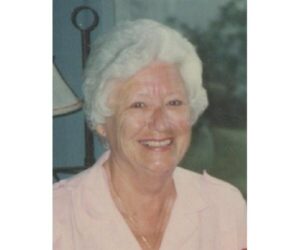Alice Wharton-Bickley
Life Dates: b. October 3, 1920, d. June 21, 2016
Full Name: Alice Leigh Jamison Wharton-Bickley
Birthplace: Cleveland, OH
Tags: Business, Volunteerism, Public History, Oral History
Alice Wharton-Bickley is best known for her work in developing the Voigt House, a perfectly preserved Victorian mansion, as a living museum in Grand Rapids. Born in Cleveland, Ohio, Alice attended a girls’ private school before attending two years at Connecticut College in New London, CT, and two years at an interior design school in Boston. While in Cleveland, at 16-years-old, Alice started to volunteer. Her parents were very civic minded, and it was stressed to her at an early age that one should give back to the community. She taught art to children; she was involved in the Junior League; and she served on the board of several organizations, including the Cleveland Hearing & Speech Center and the Art Museum of Cleveland.
During the war years, Alice worked as a tool designer for an aircraft company, Thompson Products (otherwise known as TRW). Women were hired in the trades as the men had been drafted for service. The women were known as “90-day wonders,” as they were trained for 90 days and then assigned to sit with an engineer to detail tools after they were designed. After the war ended, Alice was let go. She was then hired by an interior decorating company in Cleveland. After she was married, Alice worked for three years. Then, she and her husband had three children: two boys and one girl. In 1955, the family moved to Grand Rapids. After moving to Grand Rapids, her volunteer work included serving as the vice president of the Junior League and the head of volunteers for the local chapter of the American Red Cross.
Alice always had an interest in antiques and was fortunate to inherit beautiful pieces from her husband’s family. She opened an antique shop in Grand Rapids called “The Ancestor Shop.” During that time, she was approached to appraise the contents of the Voigt House for possible purchase. Voigt House had been left to the Grand Rapids Foundation, and the plan was to sell both the house and its contents. Alice felt it was a shame to tear down the house; WOOD-TV was across the street from the Voigt House and wanted the land for a parking lot.
The three-story Voigt House is located in the Heritage Hill area of Grand Rapids and was built for Carl G. Voigt in 1895. Mr. Voigt came to Grand Rapids in 1895 from Germany and ran flour mills. The Voigts were not “high society” types, but they had a fondness for beautiful things and
would return to Germany every year and collect wonderful art glass. The last Voigt to live in the house was Ralph Voigt, a bachelor who lived to the age of about 87.
Alice approached friends of hers who were interested in preservation of historic houses. Alice knew the Voigt House would be a major attraction for Grand Rapids so, with two friends, she approached the Grand Rapids Foundation to ask whether she and her friends could run the place as a museum for three years and be successful. She also had the backing of the Junior League, which had agreed to pay for a director for the museum. Alice set about to put the Voigt House together “like a puzzle.” Items that had been in the attic were brought out of storage and put back just as they were when the Voigts lived there. The Voigts had the same housekeeper for years, and she helped Alice put the pieces back in place, as well as shared the family’s customs.
The Voigt House opened to the public in conjunction with the Heritage Hill Tour of Homes. It became the main attraction. Volunteers served luncheons and gave guided tours. The idea was to allow people to step back in time and have lunch the way the Voigts would have entertained. They lived in the house in the early 1900s. The volunteers used original equipment and dishes from the Voigt House kitchen, which served as an educational tool for younger visitors who were intrigued by the old fashioned utensils such as the ice box, the dumbwaiter, and the call box. Besides her contributions to the Voigt House, Alice also served on the committee to recreate an exact replica of Gerald Ford’s oval office at the Gerald R. Ford Museum, one of the museum’s main attractions.
Related Links:
This biography is an adaptation of an oral history interview with Alice Wharton-Bickley. Learn more about oral histories here.
“Alice Wharton-Bickley.” Metcalf & Jonkhoff Funeral Service, 2016. https://www.metcalfandjonkhoff.com/obituary/Alice-Wharton-Bickley.

